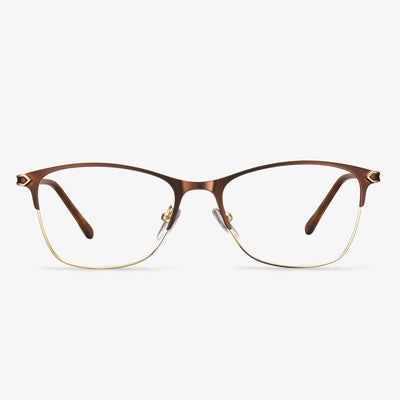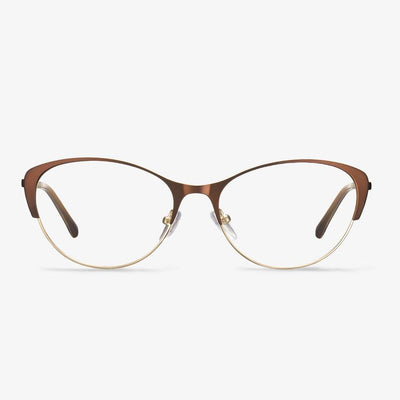What Glasses Are Made Of?
In general, most glasses are made of plastic lenses. Why are glasses lenses made of plastic? In fact, plastic glasses are lighter than traditional glasses lenses used in eyeglasses, which means they are more comfortable to wear. At the same time, it is easy to apply lens coatings like anti-reflective to plastic lenses.
Besides, children’s glasses are also made of plastic because it is more resistant to impact. There are four main types of plastics used to make eyeglasses and sunglasses lenses which are plastic, Trivex, polycarbonate and high-index plastics.
The plastic lenses made from CR-39 were first introduced. CR-39 is an abbreviation for Columbia Resin #39, the 39th plastic of that type made by Columbia Resin.
Then the polycarbonate glasses were invented. Polycarbonate became out of this world once it found use in aeronautics. Polycarbonate is a type of plastic that can be produced as transparent and easily shaped, making it great for glasses lenses. Polycarbonate is impact resistant so that they are a good lens choice for kids. And the polycarbonate lenses have 100% UV protection.
Next, high-index lenses are available. High-index lenses have a high refractive index with a thin lens. Although high-index lenses are thinner, they are heavier due to the higher density of these plastics.
So, what glasses are made of? Most glasses are made of plastics. Then how are glasses made? To get the answer, keep on your reading.
How to drive at night with glasses?
Far-light is easy to cause blind spots for drivers of opposite vehicles, and it is possible to cause traffic accidents when driving in the cities. In the process of driving, if the driver encounters the situation that a high beam disrupts the line of sight, can turn the eye in the left or right direction, avoid light sources, and allow your eyes to gradually adapt to the other person's light source. If you can't see clearly, slow down or even pull over.
The characteristics of metal material
The material of metal glasses frame chooses some kind of metal material or alloy to make mostly. Most of the copper alloys are treated as the base material and then have surface treatment processing. Then there is the recent rise of pure titanium frames and those made of memory alloy. Metal frames are usually equipped with nose pads, which are movable to accommodate a variety of nasal shapes. The end of the temple is often covered with a plastic cover, not only beautiful but also to protect the temple and skin.
What Are the Advantages of High-Index Lenses?
In this section, we will show you the advantages of high-index lenses.
- Thanks to the slim shape and narrow edges, high index lenses offer wearers the flexibility to choose from a wide array of fashion-forward frames. Their size means that they can be easily paired with sleek metal frames or incorporated into rimless eyewear for an attractive barely-there look.
- High index lenses are more comfortable for extended use because they are lighter than the traditional counterparts.
- High index lenses are available with many of the same options as traditional lenses. For example, they can be either single-vision or progressive.
- For users with strong prescriptions, high index lenses mean no bulky, bottle-glasses appearance. This can reduce the unwanted bug-eye look traditionally associated with very thick lenses.
However, there are some negative voices of high index lenses.
The characteristics are different.
Cellulose acetate materials have high wear resistance, and hardness and texture are very good. The sunglasses are made of acetate fiber plate with plate cutting and processing. The main materials are plate and plate plus steel sheets. The characteristics of the plate are that they are not heavy. It has a hardness, good gloss, and steel combined to strengthen the firm performance. And they have a beautiful style, not easy to deform and change color, durable. The plated one deduces fashion, easy-to-match clothes, and integrates the thickness of the plate and the texture of the metal, reflecting the personality style.
The chemical name of the CP material is propionic acid fiber, cellulose molecules for the hydroxyl propionic acid in the polymer. It has good weather resistance and low-temperature resistance. The current market of this material is mainly used in glasses, toys, and a variety of shells. It is one of the acrylic resin derivatives. The material is a large sheet and can be dyed in a variety of colors.
FACTORY900
It has an avant-garde design and a very three-dimensional look. Many of its designs have gone beyond traditional eyewear. It has been producing plastic frames internally for 80 years. They have a history of pursuing technology, innovation in design, and special technology of plastic molding. And they are said to be available only to them in the world. They created a new type of EYEWEAR with the concept of THE FUTURES EYEWEAR. With the addition of planning and design to internal integrated production, it has been one of the few factory brands to perform almost all processes in the factory. Its unique shape and avant-garde design are highly valued not only in Japan but around the world.
The lenses of Walmart Glasses
When Walmart first entered the eyewear business in 1991, Walmart was known for its affordable lenses, which were similar to other big stores and eyewear chains. Then, in 2000, Walmart began offering high-end Carl Zeiss lenses. Customers have noticed the change and they continue to strive to become a leader in eyewear quality. Walmart has led the way in applying anti-reflection and anti-scratch coatings to its lenses. From the beginning, Walmart took steps to provide the best products on the market, with quality levels that exceeded industry standards. The upgrades now underway will continue to deliver on that promise.











































